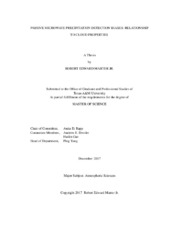| dc.description.abstract | Accurate measurement of the Earth’s hydrologic cycle requires a more precise understanding
of precipitation accumulation and intensity on a global scale. While there is a
long record of passive microwave satellite measurements, passive microwave rainfall retrievals
often fail to detect light precipitation or have light rain intensity biases because
they cannot differentiate between emission from cloud and rain water. Previous studies
have shown that AMSR-E significantly underestimates rainfall occurrence and volume
compared to CloudSat. This underestimation totals just below 0.6 mm/day quasi-globally
(60S-60N), but there are larger regional variations related to the dominant cloud regime.
This study aims to use Moderate Resolution Imaging Spectroradiometer (MODIS) and
the 94-GHz CloudSat Cloud Profiling Radar (CPR), which has a high sensitivity to light
rain, with the Advanced Microwave Scanning Radiometer for Earth Observing System
(AMSR-E) observations, to help better characterize the properties of clouds that lead
to passive microwave rainfall detection biases. CPR cloud and precipitation retrievals,
AMSR-E Level-2B Goddard Profiling 2010 Algorithm (GPROF 2010) rainfall retrievals,
and MODIS cloud properties were collocated and analyzed for 2007-2009. MODIS cloud
microphysical and macrophysical properties, such as optical thickness, particle effective
radius, and liquid water path were analyzed when precipitation is detected by CloudSat and
missed by AMSR-E. Results are consistent with past studies and show large passive microwave
precipitation detection biases compared to CloudSat in stratocumulus and shallow
cumulus regimes. An examination of cases where AMSR-E failed to detect precipitation
detected by CloudSat shows that warm rain detection biases occur more frequently within
lower LWP, τ , and CTH bins, but biases at higher LWP, τ_ , and CTH contribute more to
the total frequency of missed precipitation. Warm rain detection biases occur more frequently and biases contribute to more of the total frequency of missed precipitation for
rve > 16 µ-m. Cloud property-dependent thresholds were calculated and compared against
Advanced Microwave Scanning Radiometer (Earth Observing System) (AMSR-E) Goddard
Profiling Algorithm (GPROF). All cloud property-dependent brightness temperature
(TB) thresholds showed improvements in hit rate and volumetric hit rates. Cloud property-dependent
TB thresholds were investigated to determine if thresholds can be improved by
separately constraining data to environmental and cloud regimes. Descent and stratocumulus
regimes, which generally consist of warm clouds, showed further improvements
of warm rain detection. Results suggest that aprori knowledge of cloud property information
and environmental information could significantly improve the detection of warm
precipitation in GPROF retrievals. | en |


